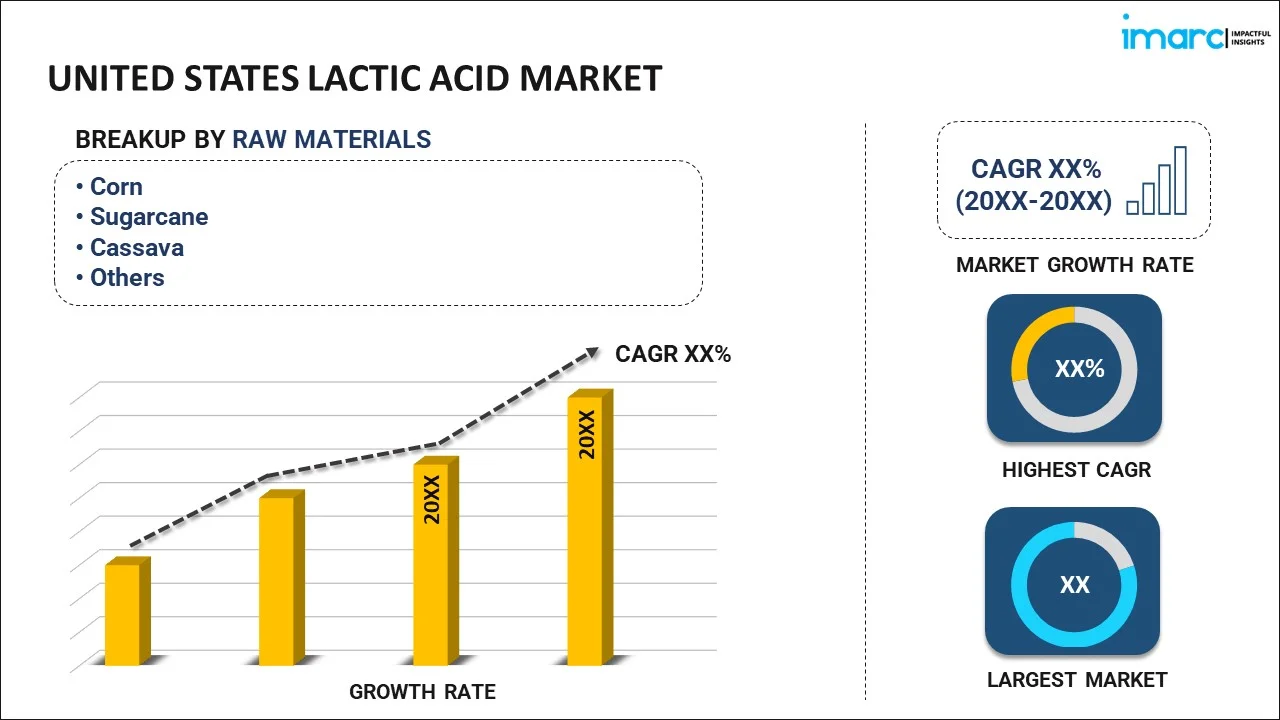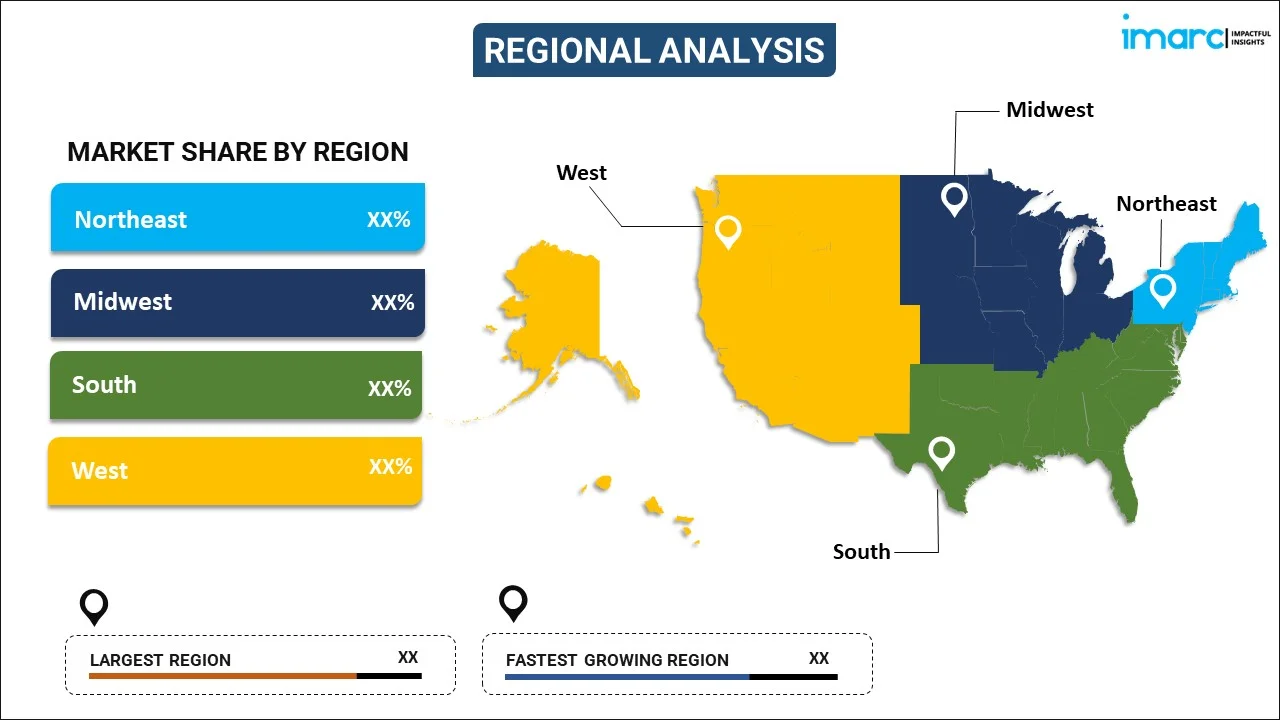
United States Lactic Acid Market Report by Raw Material (Corn, Sugarcane, Cassava, and Others), Form (Liquid, Solid), Application (Industrial, Food and Beverages, Pharmaceuticals, Personal Care, Polylactic Acid (PLA), and Others), and Region 2025-2033
Market Overview:
The United States lactic acid market size reached USD 1,062.2 Million in 2024. Looking forward, IMARC Group expects the market to reach USD 1,983.8 Million by 2033, exhibiting a growth rate (CAGR) of 6.42% during 2025-2033. The increasing consumption of lactic acid in the production of PLA-based products, continuous growth of the food and beverage sector, and the rising product adoption in various pharmaceutical and medical applications represent some of the key factors driving the market.
|
Report Attribute
|
Key Statistics
|
|---|---|
|
Base Year
|
2024 |
|
Forecast Years
|
2025-2033
|
|
Historical Years
|
2019-2024
|
| Market Size in 2024 | USD 1,062.2 Million |
| Market Forecast in 2033 | USD 1,983.8 Million |
| Market Growth Rate (2025-2033) | 6.42% |
Lactic acid is a type of organic acid that plays a crucial role in various biological processes and industrial applications. It is classified as a carboxylic acid and is characterized by its chemical structure, which consists of a carboxyl group (COOH) attached to a carbon atom that is also bonded to a hydroxyl group (OH). This chemical structure is responsible for the acid's unique properties. Lactic acid has applications in the food and beverage industry as an additive and preservative. It is used to adjust acidity levels, control pH, and enhance the flavor and texture of various food products. Lactic acid also contributes to the production of fermented foods. It is also used in cosmetic and personal care products, such as skin creams and exfoliants. It is known for its exfoliating properties and ability to promote skin renewal. In these products, it is often used as an alpha hydroxy acid (AHA). In addition, it is utilized in industrial cleaning products as an effective acid cleaner. Its ability to dissolve mineral deposits and scale makes it suitable for cleaning applications in industries such as dairy processing and descaling of industrial equipment.
United States Lactic Acid Market Trends:
Lactic acid is a key raw material to produce polylactic acid (PLA), a biodegradable and eco-friendly plastic. As environmental concerns and regulations regarding single-use plastics intensify, there is an increasing demand for biodegradable alternatives. This drives the consumption of lactic acid in the production of PLA-based products such as packaging materials, disposable cutlery, and more. In addition, the continuous growth of the food and beverage sector in the United States, coupled with the consumer preference for natural and clean-label ingredients, fuels the demand for lactic acid as a food additive. Besides, the trend toward functional and probiotic-rich foods is also contributing to the lactic acid market's growth. Lactic acid is used in the production of probiotic-rich fermented foods such as yogurt, kefir, and sauerkraut, which are known for their potential health benefits. Moreover, lactic acid is used in various pharmaceutical and medical applications. It is employed in the formulation of lactate-based intravenous solutions for the treatment of acid-base imbalances in patients. The growth of the healthcare sector and the demand for medical-grade lactic acid contribute to market expansion. Furthermore, lactic acid's ability to dissolve mineral deposits and scale makes it suitable for industrial cleaning and descaling applications. Industries such as dairy processing, beverage production, and manufacturing rely on lactic acid-based cleaning solutions to maintain equipment and ensure hygiene standards, representing another major growth-inducing factor.
United States Lactic Acid Market Segmentation:
IMARC Group provides an analysis of the key trends in each segment of the market, along with forecasts at the country level for 2025-2033. Our report has categorized the market based on raw material, form, and application.
Raw Material Insights:

- Corn
- Sugarcane
- Cassava
- Others
The report has provided a detailed breakup and analysis of the market based on the raw material. This includes corn, sugarcane, cassava, and others.
Form Insights:
- Liquid
- Solid
A detailed breakup and analysis of the market based on the form have also been provided in the report. This includes liquid and solid.
Application Insights:
- Industrial
- Food and Beverages
- Pharmaceuticals
- Personal Care
- Polylactic Acid (PLA)
- Others
The report has provided a detailed breakup and analysis of the market based on the application. This includes industrial, food and beverages, pharmaceuticals, personal care, polylactic acid (PLA), and others.
Regional Insights:

- Northeast
- Midwest
- South
- West
The report has also provided a comprehensive analysis of all the major regional markets, which include Northeast, Midwest, South, and West.
Competitive Landscape:
The market research report has also provided a comprehensive analysis of the competitive landscape. Competitive analysis such as market structure, key player positioning, top winning strategies, competitive dashboard, and company evaluation quadrant has been covered in the report. Also, detailed profiles of all major companies have been provided.
United States Lactic Acid Market Report Coverage:
| Report Features | Details |
|---|---|
| Base Year of the Analysis | 2024 |
| Historical Period | 2019-2024 |
| Forecast Period | 2025-2033 |
| Units | Million USD |
| Scope of the Report | Exploration of Historical Trends and Market Outlook, Industry Catalysts and Challenges, Segment-Wise Historical and Future Market Assessment:
|
| Raw Materials Covered | Corn, Sugarcane, Cassava, Others |
| Forms Covered | Liquid, Solid |
| Applications Covered | Industrial, Food and Beverages, Pharmaceuticals, Personal Care, Polylactic Acid (PLA), Others |
| Regions Covered | Northeast, Midwest, South, West |
| Customization Scope | 10% Free Customization |
| Post-Sale Analyst Support | 10-12 Weeks |
| Delivery Format | PDF and Excel through Email (We can also provide the editable version of the report in PPT/Word format on special request) |
Key Questions Answered in This Report:
- How has the United States lactic acid market performed so far and how will it perform in the coming years?
- What has been the impact of COVID-19 on the United States lactic acid market?
- What is the breakup of the United States lactic acid market on the basis of raw material?
- What is the breakup of the United States lactic acid market on the basis of form?
- What is the breakup of the United States lactic acid market on the basis of application?
- What are the various stages in the value chain of the United States lactic acid market?
- What are the key driving factors and challenges in the United States lactic acid?
- What is the structure of the United States lactic acid market and who are the key players?
- What is the degree of competition in the United States lactic acid market?
Key Benefits for Stakeholders:
- IMARC’s industry report offers a comprehensive quantitative analysis of various market segments, historical and current market trends, market forecasts, and dynamics of the United States lactic acid market from 2019-2033.
- The research report provides the latest information on the market drivers, challenges, and opportunities in the United States lactic acid market.
- Porter's five forces analysis assist stakeholders in assessing the impact of new entrants, competitive rivalry, supplier power, buyer power, and the threat of substitution. It helps stakeholders to analyze the level of competition within the United States lactic acid industry and its attractiveness.
- Competitive landscape allows stakeholders to understand their competitive environment and provides an insight into the current positions of key players in the market.
Need more help?
- Speak to our experienced analysts for insights on the current market scenarios.
- Include additional segments and countries to customize the report as per your requirement.
- Gain an unparalleled competitive advantage in your domain by understanding how to utilize the report and positively impacting your operations and revenue.
- For further assistance, please connect with our analysts.
 Inquire Before Buying
Inquire Before Buying
 Speak to an Analyst
Speak to an Analyst
 Request Brochure
Request Brochure
 Request Customization
Request Customization




.webp)




.webp)












